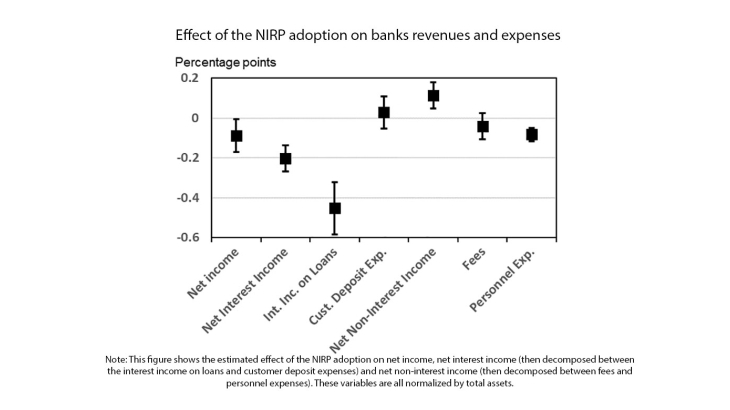Since 2012, several central banks in Europe and the Bank of Japan have introduced negative policy interest rates. The effectiveness of such policy depends crucially on the pass-through to the lending and deposit rates. However, it seems that the pass-through of negative interest rates to deposit rates is not perfect because of their downward rigidity. At least, two reasons can explain the reluctance of banks to introduce a negative deposit rate: (i) some legal constraints and (ii) the fear of a “cash rush”. Therefore, negative interest rate policies (NIRP) could negatively affect banks’ profitability by compressing net interest margins due to the lower bound for deposit rates.
In order to preserve their profitability and offset the fall in net interest margins, commercial banks face different options: (i) foster credit supply to mitigate the reduction in margins with an increase in volumes, (ii) redirect their income from interest products towards non-interest sources (such as fees and commissions), (iii) reduce their operating costs (such as salaries and employee benefits), by focusing more on digital banking for instance, or (iv) reduce the interest rate paid on non-customer deposit liabilities.
The analysis draws on yearly bank-level data for 3637 banks in 59 countries between 2011 and 2018. Our identification relies on the comparison between banks in the 25 countries that have adopted negative interest rates and those in the remaining countries that have not. We find that negative interest rates reduce banks’ net interest income by around 0.2 percentage points. Our results confirm evidence of the existence of a zero-lower bound on deposit interest rates: banks located in countries that have adopted NIRP are reluctant to charge a negative interest rate on customer deposits. We also find that banks increase their net non-interest income to offset the effects of negative interest rates on their net interest income. Our results indicate that the increase in banks’ net non-interest income, in response to NIRP, is related to a reduction in non-interest expenses rather than to an increase in fees and commissions. We find a 0.1 percentage point reduction in personnel expenses following the NIRP implementation.
